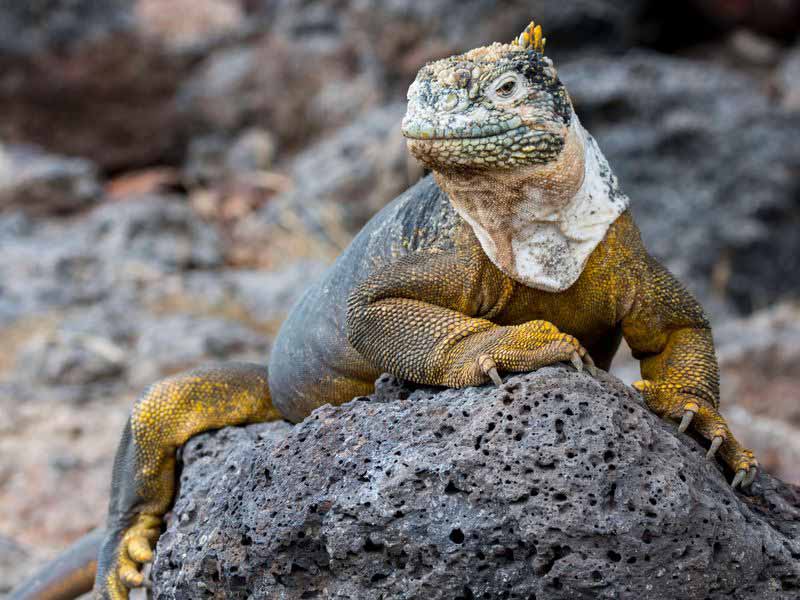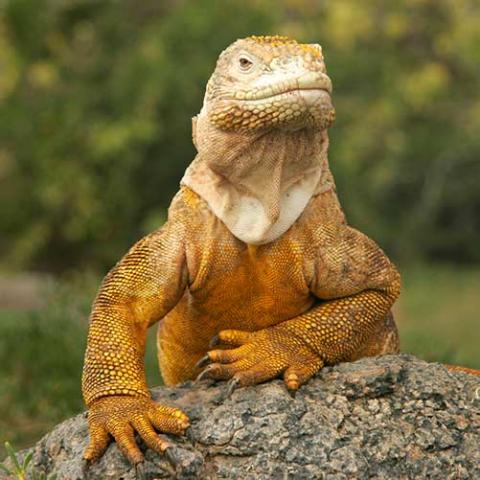NAMES
TAXONOMY
Ecuador
Issued:
Stamp:
Conolophus subcristatus
Ecuador
Issued:
Stamp:
Conolophus subcristatus
Ecuador
Issued:
Stamp:
Conolophus subcristatus
An Iguana Species Last Documented by Charles Darwin Has Been Reintroduced to a Galápagos Island
The Galápagos land iguana on Santiago Island was decimated by invasive animals like cats, dogs and pigs

During his journey to the Galápagos in 1835, Charles Darwin spotted land iguanas racing about on the island of Santiago. He wasn’t a fan. “From their low facial angle they have a singularly stupid appearance,” he wrote, also opining that the animals are “lazy and half torpid.”
Darwin, with his rather unforgiving assessment, was the last person to officially record a sighting of the reptiles on Santiago Island, nearly 200 years ago. The iguanas were decimated by foreign animals introduced by mariners and early settlers of the Galápagos. But there may be new hope for the iguanas of Santiago. As the Agence France-Presse reports, more than 1,400 land iguanas have been reintroduced to the island as part of a restoration program.
The Galápagos National Park authority explained on Facebook that the land iguanas, also known by their scientific name Conolophus subcristatus, had been relocated from the neighboring North Seymour Island, where the animals are far more plentiful; around 5,000 individuals lived there before part of the population was move to Santiago Island, according to the park. In fact, reducing land iguana numbers on North Seymour Island may prove beneficial since food resources, particularly cacti, are limited there.
The restoration initiative is taking place in a number of phases. Last year, land iguanas on North Seymour Island were captured and quarantined. On January 3rd and 4th of this year, they were released onto coastal regions of Santiago, which “have ecosystems similar to those of their natural habitat, with the presence of abundant vegetation for their food,” the park says. The team, which includes park officials and experts from New Zealand's Massey University, will begin monitoring the iguanas next month. CNN’s Emily Dixon reports that experts will be looking to see if the iguanas are building nests and getting enough food. They’ll also keep a close eye on species like rodents and ants, which pose a threat to the iguanas' nests.
In the past, Galápagos land iguana populations plummeted due to introduced animals like cats, dogs and rats, which competed with the animals for food and preyed on their eggs and young. But a major culprit in the reptiles’ decline has been pigs, which were brought to the island in the 1800s and have since run wild. Omnivorous and ravenous, feral pigs are “thought to have played a big role in many of the extinctions and ecosystem degradation on the Galápagos Islands,” according to the Galápagos Conservation Trust
Fortunately, the porcine predators won’t be pestering Santiago Island’s newest inhabitants. Pigs and other introduced mammals, like donkeys and goats, were eradicated there as part of a conservation project that took place between 1997 and 2006.
Galápagos land iguanas, a large species with powerful hind legs and yellow skin, are one of just three iguana species that are endemic to the Galápagos Islands. Danny Rueda, the park authority’s ecosystems director, notes that the land iguana “helps ecosystems through the dispersal of seeds and the maintenance of open spaces without vegetation.” In other words, Darwin’s opinions notwithstanding, the land iguana may play an important role in the ecological recovery of Santiago Island.
Reference: www.smithsonianmag.com
Genus species (Animalia): Conolophus subcristatus
The Galapagos land iguana (Conolophus subcristatus) is a species of lizard in the family Iguanidae. It is one of three species of the genus Conolophus. It is endemic to the Galápagos Islands (Ecuador), in the dry lowlands of Fernandina, Isabela, Santa Cruz, North Seymour, Baltra, and South Plaza Islands
Anatomy and morphology
Charles Darwin described the Galapagos land iguana as "ugly animals, of a yellowish orange beneath, and of a brownish-red colour above: from their low facial angle they have a singularly stupid appearance." The Galapagos land iguana grows to a length of 0.9 to 1.5 m (3–5 ft) with a body weight of up to 11 kg (25 lb), depending upon which island they are from. Being cold-blooded, they absorb heat from the sun by basking on volcanic rock, and at night sleep in burrows to conserve their body heat. These iguanas also enjoy a symbiotic relationship with birds; the birds remove parasites and ticks, providing relief to the iguanas and food for the birds.
Diet and longevity
Land iguanas are primarily herbivorous; however, some individuals have shown that they are opportunistic carnivores supplementing their diet with insects, centipedes and carrion. Because fresh water is scarce on its island habitats, the Galapagos land iguana obtains the majority of its moisture from the prickly-pear cactus, which makes up 80% of its diet. All parts of the plant are consumed, including the fruit, flowers, pads, and even spines. During the rainy season it will drink from available standing pools of water and feast on yellow flowers of the genus Portulaca.
The Galapagos land iguana has a 60 to 69 year lifespan.
Reference: Wikipedia
Photo: Paul McFarling



